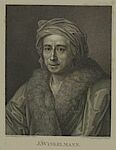Johann Joachim Winckelmann (1717-1768)
Johann Joachim Winckelmann
Winckelmann was the son of a cobbler and came from a poor social background. He studied theology in Halle from 1738 until 1742 as well as medicine and mathematics in Jena. His studies were interrupted through a position as a tutor, which he accepted in Osterburg. He became deputy head in 1743 in Seehausen, which he gave up once he was offered the position of second librarian in Nöthnitz by Count von Bünau. Inspired by A. Archinto, the papal nuntius in Dresden, Winckelmann moved to Rome in 1755 with a pension from the Saxony Electorate in his pocket. Previously, however, he had converted to Catholicism in order to be promoted. In Rome he became librarian for the Cardinals A. Antichi and A. Albani. In 1763 he moved on to ‘Scrittore’ at the Vaticana and successor of M. Venuti ‘Prefetto dell’Antichità’. In 1768, on his untimely return from his journey from Germany, Winckelmann died a victim of a fraudulent murder in Triest.
Biographical Links
The Dictionary of Art Historians
Wikipedia
Even though J. J. Winckelmann’s research focused on the fine arts of Greek and Roman Antiquity, he can be regarded as a founder of modern art history due to his seminal methodical achievements and his references to Early Modern Art. With regard to contemporary Art Literature he turned against pure eruditeness of books and demanded the study of works of art as the premise for the knowledge of art. Similarly, he was the first to recognize the description of art as a methodical problem in the science of fine arts. Thus, with his descriptions of the Belvedere-Sculptures he developed an a novel and appropriate method. With his work Geschichte der Kunst des Altertums he distanced himself from art history as the history of artists and focused on art itself and its historical progression, which though dependent of its cultural context manifests itself a stylistic development. However, Winckelmann’s understanding of history remains in conflict with the a-historic propagation of Greek Art as a principal archetype. This in particular concerns the Gedanken über die Nachahmung der griechischen Werke, of which originally only 50 copies were available. It was through this work that Winckelmann, whose views on art were considerably influenced by A.F. Oeser and A.R. Mengs, became famous. His works with their normative impetus had a major influence on 18th century artists. Despite the contemporary admiration for Winckelmann, which came close to adoration, his works by all means were nevertheless criticized without delay, for example by G.H. Lessing and J.G. v. Herder. (S.E. translated by A.B.)
Johann Joachim Winckelmann- digital scroll to top
Winckelmann, Johann Joachim
Gedanken ueber die Nachahmung der griechischen Werke in der Malerey und Bildhauerkunst: [nebst Erläuterung dazu]
Dresden, Leipzig, 1756
Winckelmann, Johann Joachim
Johann Winckelmanns Sendschreiben von den Herculanischen Entdeckungen: an den Hochgebohrnen Herrn, Herrn Heinrich Reichsgrafen von Bruehl
Dresden, 1762
Winckelmann, Johann Joachim
Geschichte der Kunst des Alterthums
Dresden, 1764
Winckelmann, Johann Joachim
Johann Winckelmanns Nachrichten von den neuesten Herculanischen Entdeckungen: an Hn. Heinrich Fuessli aus Zuerich
Dresden, 1764
Winckelmann, Johann Joachim
Anmerkungen über die Geschichte der Kunst des Alterthums
Dresden, 1767
Winckelmann, Johann Joachim
Monumenti antichi inediti
Roma, 1767
Winckelmann, Johann Joachim; Usteri, Leonhard [Hrsg.]
Winckelmanns Briefe an seine Freunde in der Schweiz
Zürich, 1778
Winckelmann, Johann Joachim; Uhde-Bernays, Hermann [Hrsg.]
J. J. Winckelmanns kleine Schriften und Briefe
Leipzig
Further Reading scroll to top
- Literature on and by Johann Joachim Winckelmann im Catalogue FID Art History Heidelberg
- Literature on and by Johann Joachim Winckelmann in Union Catalogue / Art Libraries Network Florence - Munich - Paris - Rome
- Literature by Johann Joachim Winckelmann in the German National Library
- Digitized Literature on and by Johann Joachim Winckelmann in Google Books
- Digitized Literature on and by Johann Joachim Winckelmann in Propyleaum-DOK
